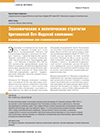Экономические и политические стратегии британской Ост-Индской компании: взаимодополнение или взаимоисключение?
DOI: 10.33917/es-4.162.2019.92-99
В статье рассмотрен вопрос соотношения торговой и властной природы Ост-Индской компании (1600–1874 гг.) как ключевого агента Британской империи в Азии. Прослежены основные этапы ее деятельности, объяснена трансформация ее стратегий и целей. Если в первые полтора столетия экономические и политические стратегии компании дополняли друг друга при приоритете первых, то с институциональной мутацией компании в середине XVIII в. между стратегиями возникло напряжение. Приход компании к власти в Бенгалии, установление государственного контроля над компанией и британская промышленная революция не только вывели на первый план политические стратегии компании, но и заменили ее экономические цели политическими, сделав компанию инструментом управления Индией
Источники:
|
1. Олтаржевский В.П., Бейдина Т.Е., Воронкова Г.В. Английская Ост-Индская Компания в XVII веке. Иркутск: Изд-во Иркут. ун-та, 1988. С. 14. 2. Marshall P.J. East Indian Fortunes: The British in Bengal in the Eighteenth Century. Oxford: Clarendon Press, 1976. P. 57. 3. Ghulam Husain, Salim. The Riyazu-s-Salatin. Calcutta: Asiatic Society of Bengal, 1898 (фарси). P. 33. 4. Braudel F. Civilisation matйrielle, economie et capitalisme, XVe — XVIIIe siиcle. 3 t. P.: Armand Colin, 1979. T. III. Le temps du monde. P. 621. 5. Auber P. Rise and Progress of the British Power in India. 2 vols. L.: W.H. Allen, 1837. Vol. I. P. 621. P. 44. 6. Bayly C.A. Indian Society and the Making of the British Empire / The New Cambridge History of India. Vol. II.1. Cambridge: Cambridge University Press, 1988. P. 46. 7. A Collection of Treaties and Engagements with the Native Princes and States of Asia Concluded, on Behalf of the East India Company, by the British Governments in India; also Copies of Sunnuds, or Grants, of Certain Privileges and Immunities to the East India Company by the Mogul, and Other Native Princes of Hindustan. L.: Cox and Son, 1812. P. 39–42. 8. Indian Constitutional Documents 1757–1939 / Ed. By A.C. Banerjee. 3 vols. Calcutta: A. Mukherjee, 1948. Vol. I. 1757–1858. P. 10–12. 9. Bowen H.V. The Business of Empire: The East India Company and Imperial Britain, 1756–1833. Cambridge etc.: Cambridge University Press, 2006. P. 224. 10. Robins N. The Corporation That Changed the World: How the East India Company Shaped the Modern Multinational. Hyderabad: Orient Longman, 2006. P. 147. 11. Bayly C.A. Imperial Meridian: The British Empire and the World, 1780–1830. L.; N.Y.: Longman, 1989. P. 106. 12. Wilbur M.E. The East India Company and the British Empire in the Far East. N.Y.: Richard R. Smith, 1945. P. 366. 13. Nightingale P. Trade and Empire in Western India, 1784–1806. Cambridge: Cambridge University Press, 1970. P. 184. 14. Erikson E. Between Monopoly and Free Trade: The English East India Company, 1600–1757. Princeton (N.J.); Oxford: Princeton University Press, 2014. P. 178. 15. Arrighi G. The Long Twentieth Century: Money, Power, and the Origins of Our Times. L.; N.Y.: Verso, 1994. P. 127–158. |



